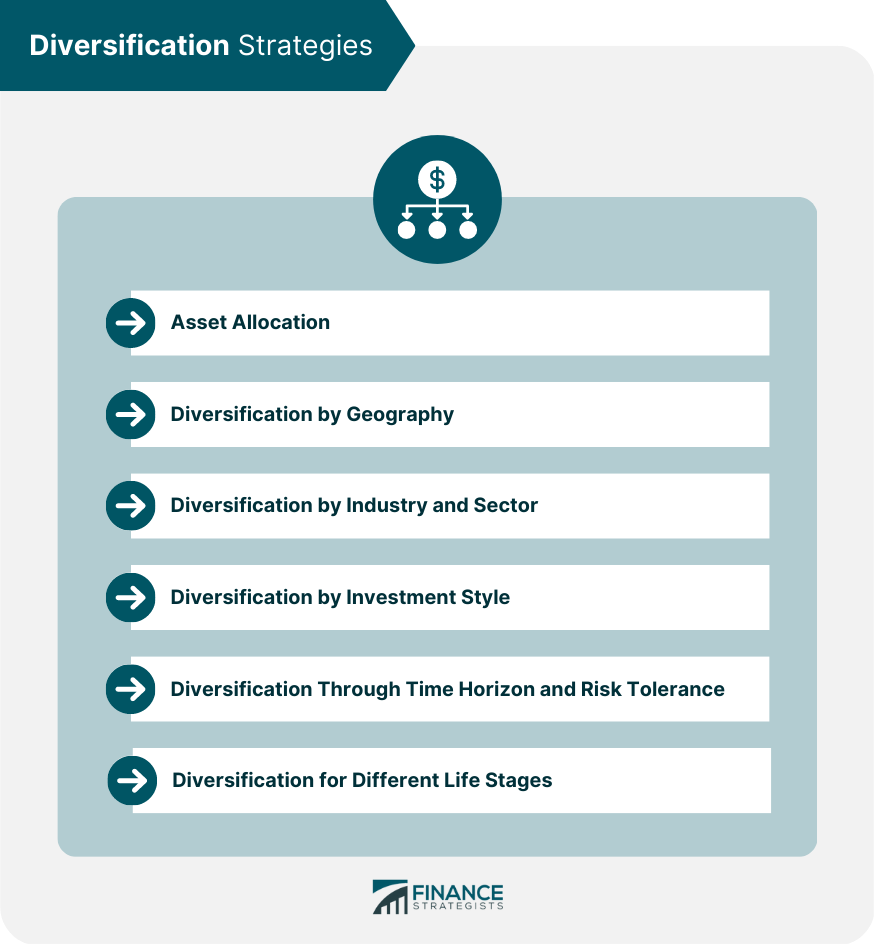Diversification strategies in finance refer to the practice of spreading your investments across a range of different assets and markets to help minimize risk and maximize returns. By investing in a variety of different asset classes, sectors, and regions, you can potentially offset losses in one area with gains in another, and reduce the impact of market volatility on your portfolio. The goal of diversification strategies in finance is to achieve a well-balanced portfolio that aligns with your investment goals and risk tolerance. These strategies involve spreading investments across a range of assets, geographies, industries, and investment styles to reduce the impact of poor-performing investments on the overall portfolio. Asset Allocation Asset allocation is the process of dividing an investment portfolio among different asset classes, such as stocks, bonds, cash, and other investments. It is a critical component of diversification strategies in finance, as it helps investors reduce the risk of holding a single type of asset while also potentially increasing returns. Stocks, or equities, represent ownership shares in a company. They offer investors the potential for capital appreciation and dividend income. Stocks can be further classified into large-cap, mid-cap, and small-cap stocks. Bonds are debt securities issued by governments or corporations to raise capital. Investors who purchase bonds receive regular interest payments and the return of the principal amount when the bond matures. Cash and cash equivalents include currency, bank deposits, and highly liquid short-term investments, such as money market funds. These assets provide safety and liquidity but typically offer lower returns compared to stocks and bonds. Real estate investments include residential, commercial, and industrial properties. Investors can gain exposure to real estate through direct property ownership or through real estate investment trusts (REITs). Commodities are physical goods, such as oil, gold, and agricultural products. Investors can invest in commodities through futures contracts, exchange-traded funds (ETFs), or stocks of companies involved in commodity production and distribution. Alternative investments encompass a broad range of non-traditional assets, such as private equity, hedge funds, and collectibles. These investments can offer diversification benefits but may also entail higher risks and lower liquidity. Strategic asset allocation involves setting a long-term target allocation for each asset class based on an investor's risk tolerance, financial goals, and time horizon. Tactical asset allocation, on the other hand, involves making short-term adjustments to the portfolio in response to market conditions or changing investment opportunities. Investing in both domestic and international markets can help spread risk and potentially enhance returns. Domestic investments offer familiarity and lower currency risk, while international investments provide access to faster-growing economies and global market opportunities. Global diversification can reduce overall portfolio risk by spreading investments across countries with different economic cycles, political environments, and currency exposures. It also allows investors to capitalize on opportunities in emerging markets and diversify away from domestic economic risks. International investing comes with its own set of risks, including currency fluctuations, political instability, and differences in accounting standards and regulatory environments. Investors must carefully consider these risks when adding international exposure to their portfolios. Industry and sector diversification involve spreading investments across various industries, such as technology, healthcare, and financial services. This strategy helps reduce the impact of poor-performing industries on the overall portfolio and allows investors to capitalize on the growth potential of different sectors. Major industries and sectors include technology, healthcare, financial services, consumer discretionary, consumer staples, industrials, materials, energy, utilities, and real estate. Investing across different industries and sectors can help investors mitigate the risks associated with industry-specific factors, such as regulatory changes, technological advancements, and economic shifts. It also enables investors to take advantage of potential growth opportunities in high-performing sectors. Investors should be mindful of the risks associated with overconcentration in a particular industry or sector. Market conditions, technological changes, and macroeconomic factors can impact the performance of individual sectors, making diversification an essential component of risk management. Growth investing focuses on companies with strong potential for future earnings growth, while value investing seeks to identify undervalued companies with solid fundamentals. Diversifying between growth and value stocks can provide exposure to different market conditions and investment opportunities. Active investing involves selecting individual investments with the goal of outperforming the market, while passive investing seeks to match market performance by investing in broad market indexes. A diversified portfolio can benefit from a mix of both active and passive investment strategies. Investment style diversification helps investors capitalize on different market opportunities and reduces reliance on any single investment approach. Combining growth, value, active, and passive investments can help to manage risk and enhance returns. Investors should be aware of the potential risks and costs associated with different investment styles, such as management fees for active funds and the risk of underperformance for growth stocks. Time horizon and risk tolerance are crucial factors in determining an appropriate diversification strategy. Time horizon refers to the length of time an investor plans to hold their investments, while risk tolerance reflects the investor's willingness to accept fluctuations in investment value. Investors should assess their risk tolerance by considering factors such as their financial goals, investment experience, and emotional reactions to market fluctuations. A well-diversified portfolio should reflect the investor's risk tolerance and time horizon. Investors with longer time horizons can generally afford to take on more risk, as they have more time to recover from market downturns. Conversely, investors with shorter time horizons may need to prioritize capital preservation and invest more conservatively. During the accumulation stage, investors are focused on building wealth and can typically afford to take on higher risk. A more aggressive diversification strategy, with a higher allocation to stocks and alternative investments, may be appropriate during this stage. As investors approach retirement, the focus shifts to preserving wealth and generating income. A more conservative diversification strategy, with a higher allocation to bonds and cash, may be suitable during the consolidation stage. In the spending and distribution stage, investors need to generate income from their investments while preserving capital. A balanced diversification strategy, with an emphasis on income-producing assets like bonds and dividend-paying stocks, may be appropriate during this stage. Rebalancing involves periodically adjusting the allocations within a portfolio to maintain the desired level of diversification. It is essential for managing risk and ensuring that the portfolio continues to reflect the investor's risk tolerance and financial goals. Rebalancing can be done on a periodic basis, such as annually or quarterly, or based on specific triggers, such as significant market changes or deviations from target allocations. Investors can rebalance their portfolios by selling overrepresented assets and buying underrepresented assets or by using new contributions to purchase underrepresented assets. Rebalancing may have tax implications, particularly when selling assets that have appreciated in value. Investors should consider the potential tax consequences of rebalancing and may choose to implement tax-efficient strategies, such as rebalancing within tax-advantaged accounts or using tax-loss harvesting techniques. Diversification strategies in finance play a crucial role in managing investment risk and maximizing returns. By spreading investments across various asset classes, geographies, industries, and investment styles, investors can reduce the impact of poor-performing investments on their portfolios. Regular rebalancing and portfolio maintenance are essential for ensuring that the portfolio continues to align with the investor's risk tolerance and financial goals. Staying up-to-date with market trends and changes and seeking professional advice can further aid in developing and maintaining a well-diversified investment portfolio.What Are Diversification Strategies?
Definition and Importance
Types of Assets
Stocks
Bonds
Cash and Cash Equivalents
Real Estate
Commodities
Alternative Investments

Strategic vs Tactical Asset Allocation
Diversification by Geography
Domestic vs International Investments
Benefits of Global Diversification
Challenges and Risks
Diversification by Industry and Sector
Definition and Importance
Types of Industries and Sectors
Benefits of Industry and Sector Diversification
Challenges and Risks
Diversification by Investment Style
Growth vs Value Investing
Active vs Passive Investing
Benefits of Investment Style Diversification
Challenges and Risks
Diversification Through Time Horizon and Risk Tolerance
Definition and Importance
Risk Tolerance Assessment
Diversification Across Different Time Horizons
Diversification Strategies for Different Life Stages
Accumulation Stage
Consolidation Stage
Spending and Distribution Stage

Rebalancing and Portfolio Maintenance
Importance of Rebalancing
Frequency and Methods of Rebalancing
Tax Implications and Considerations
Conclusion
Diversification Strategies FAQs
Diversification in investment is the practice of investing in a variety of different assets across different industries, sectors, and regions to help reduce the overall risk in your portfolio. By spreading your investments across different types of assets, you can potentially offset losses in one area with gains in another.
Diversification is important in investing because it helps to reduce the overall risk of your portfolio. By investing in a variety of different assets, you can potentially minimize the impact of market volatility and increase the potential for long-term growth.
There are several different types of diversification strategies, such as asset allocation diversification, sector diversification, geographical diversification, and time diversification. Each strategy involves investing in different types of assets across different sectors, regions, and time horizons to help reduce the overall risk of your portfolio.
An investor can implement a diversification strategy by first identifying their investment goals and risk tolerance. They can then determine the appropriate asset allocation mix and select investments across different asset classes, sectors, and regions. It's important to regularly monitor and adjust your portfolio as needed to ensure that it remains diversified and aligned with your investment goals.
A well-diversified portfolio can potentially provide several benefits, such as reduced overall portfolio risk, increased potential for long-term growth, protection against market volatility and downturns, and improved chances of meeting your investment goals. By investing in a variety of different assets, you can potentially minimize the impact of market fluctuations and increase the likelihood of achieving your investment objectives.
True Tamplin is a published author, public speaker, CEO of UpDigital, and founder of Finance Strategists.
True is a Certified Educator in Personal Finance (CEPF®), author of The Handy Financial Ratios Guide, a member of the Society for Advancing Business Editing and Writing, contributes to his financial education site, Finance Strategists, and has spoken to various financial communities such as the CFA Institute, as well as university students like his Alma mater, Biola University, where he received a bachelor of science in business and data analytics.
To learn more about True, visit his personal website or view his author profiles on Amazon, Nasdaq and Forbes.















